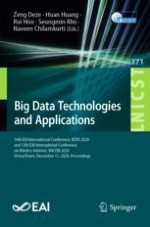2021 | Buch
Big Data Technologies and Applications
10th EAI International Conference, BDTA 2020, and 13th EAI International Conference on Wireless Internet, WiCON 2020, Virtual Event, December 11, 2020, Proceedings
herausgegeben von: Dr. Zeng Deze, Huan Huang, Rui Hou, Seungmin Rho, Dr. Naveen Chilamkurti
Verlag: Springer International Publishing
Buchreihe : Lecture Notes of the Institute for Computer Sciences, Social Informatics and Telecommunications Engineering
